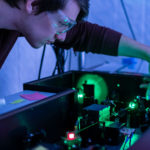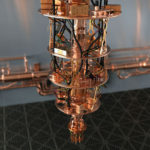Quantum Computing: How it differs from classical computing?
The race to make good on quantum computing is well underway. Millions of dollars have been allocated to developing machines that could cause current computers to become obsolete. But, what is the difference between quantum and classical computing? This is a puzzle that is beginning to be unraveled.

A few months ago, IBM unveiled the first quantum computer, the Q System. For newcomers to this computing paradigm, IBM explained that the quantum computer could solve (much more quickly than traditional computers) a set of much more complex calculations. “Qubits” were discussed as units of value, outpacing the traditional bits of classical computing.
To understand how a quantum computer works, and the quantum mechanics on which it is based, we should look back to the beginning of the 20th century, when this physical theory was first raised. Among other subjects of study, quantum physics began with the study of an atom's particles and its electrons at a microscopic scale, something that had never been done before. Arnau Riera — doctor in theoretical physics; high school teacher; and advisor to Quantum, an exhibition hosted at the Center of Contemporary Culture of Barcelona (CCCB) — defines it as a conceptual change. "In the classical world, the properties of the systems that we study are well defined. In the quantum world, this isn’t the case: particles can have different values, they are not isolated objects, their states are diluted," he explains.
Quantum physics is so complex that even Richard Feyman, 1965 Nobel Laureate in Physics and one of the fathers of quantum computing in the 1980s famously said, "I think I can safely say that nobody understands quantum mechanics”.
As the reality of a quantum computer comes closer, it is useful for us to understand both how one functions and how it’s different from a traditional computer. The first thing to bear in mind is that they use different basic units of data: 'bits' and 'qubits'. Every element of a classical computer is written in binary code (1s and 0s) and is translated into electricity: high voltage is represented by 1, and low voltage by 0. In quantum computing, qubits are the basic unit and their value can be 1, 0, or 1 and 0 simultaneously, overlapping (superposition) and intertwining (entanglement) according to the laws of physics. This means that qubits, as opposed to bits, can take on various values at one time and can perform calculations that a conventional computer cannot.
Juan José García Ripoll, researcher at the Institute of Fundamental Physics within the Spanish National Research Council, provides more clues. "In classical computing we know how to solve problems thanks to computer language (AND, OR NOT) used when programming. Operations that are not feasible in bit computing can be performed with a quantum computer. In a quantum computer all the numbers and possibilities that can be created with N qubits are superimposed (if there are 3 qubits, there will be 8 simultaneous possible permutations.) With 1,000 qubits the exponential possibilities far exceed those that we have in classical computing”.
Currently, in contrast to classical computing, there are no quantum computing languages per se. Researchers work on developing algorithms (mathematical models that classical computers also work with) that can provide concrete solutions to the problems that are presented. "They work differently. A quantum computer isn't suitable for performing day-to-day tasks", Garcia Ripoll explains. "They don't have memory or a processor. We only have a group of qubits that we use to write information, and we work with those. There isn't an architecture as complicated as the architecture for a conventional computer. Today, quantum machines are primitive systems akin to a calculator at the turn of the last century, but their computing power for very specific problems is much greater than a traditional computer's. There is a dichotomy between what appears very simple and what it does, which is very powerful,” García Ripoll points out.

What is a quantum computer like and under what conditions does it work?
When IBM unveiled its quantum computer, many people were surprised by what it looked like. There were no screens, keyboards, or processors — computers elements we expect. In the photos there appears a bell-shaped machine covered in copper wires, then by a protective glass case. Only people who work with quantum computers and researchers can get close to this equipment. Researchers at CSIC use traditional computers and the cloud to interact with the quantum computers used for their research.
“What we have available are prototypes that are very sensitive; they experience errors. They are very complex technically because as soon as an external agent influences or interacts with a quantum system, the qubits register it and fall out of superposition”, explains Riera. Whereas, with a classical computer, if there is interference with the system, the system can correct itself and continue running. For the time being, this is not the case with quantum computers. "External disturbances force the system to define itself as 1 or 0, causing it to lose its quantum coherence. To avoid this kind of external ‘noise,’ the system has to be completely isolated: the atoms have to be very quiet, ensuring nothing makes them collide or interact with the surroundings. This kind of ‘still state’ requires exact temperatures and processes,” the doctor in theoretical physics explains. Quantum computers have to be at a temperature of -273 °C (-459 °F) with hardly any atmospheric pressure and isolated from Earth's magnetic field.
At the same time, information cannot be stored in a quantum computer because its operational window is very short. "It's computing time is finite: at some point the quantum properties of the computer are destroyed. They run for very short periods of time. We have to think about how to make the most of those timeframes and extract data in a very exact manner,” García Ripoll explains.
What can we do with a quantum computer?
Areas where quantum computing can deliver new applications and developments range from the pharmaceutical industry and medicine research, the creation of new materials, and even what is being called “quantum finance” — an area in which BBVA has already taken an interest. In this sector, we can use classical computing and mathematical algorithms to make predictions about the future risk of a portfolio or we can study the stock market during a window of time. But quantum computing opens a completely new range of options to be explored. "A quantum computer can create superposition with multiple probabilities that we cannot achieve today, let alone examine the features of those probabilities. With this type of application, the quantum computer will be much more efficient than a classical computer,” asserts García Ripoll.
Despite all the possibilities promised by quantum computing, we mustn't get ahead of ourselves, particularly in everyday life. We won't see massive improvements in speed when downloading videos; nor will video game players benefit from even better graphics cards. Researchers are working on algorithms and mathematical models so that in a near future tasks that take a long time today can be executed more efficiently. "Quantum computing is just getting started, we are very much in the early days," concludes Garcáa Ripoll.